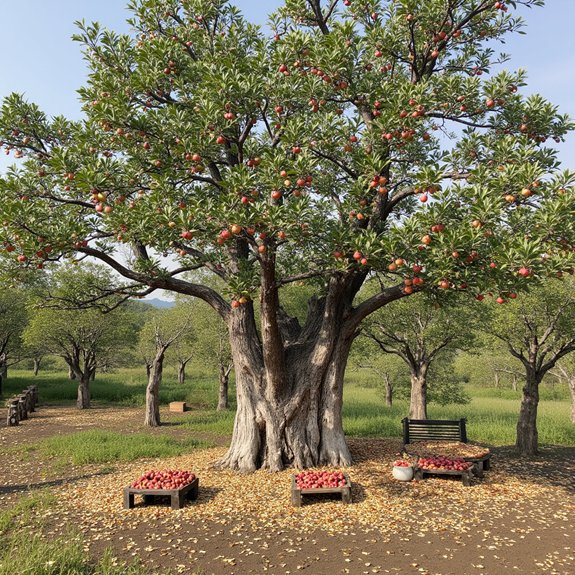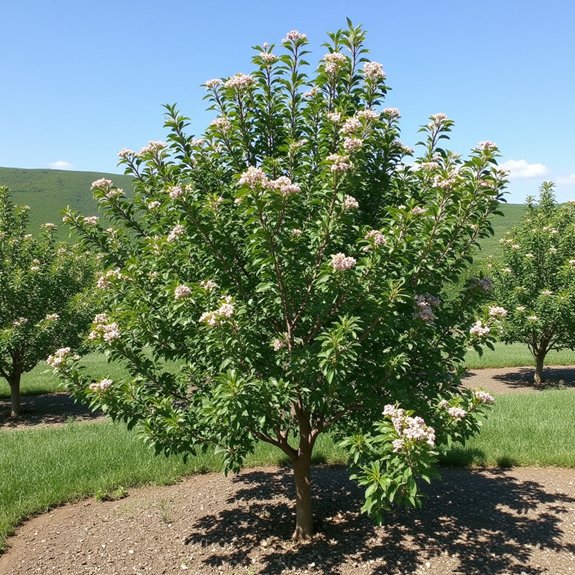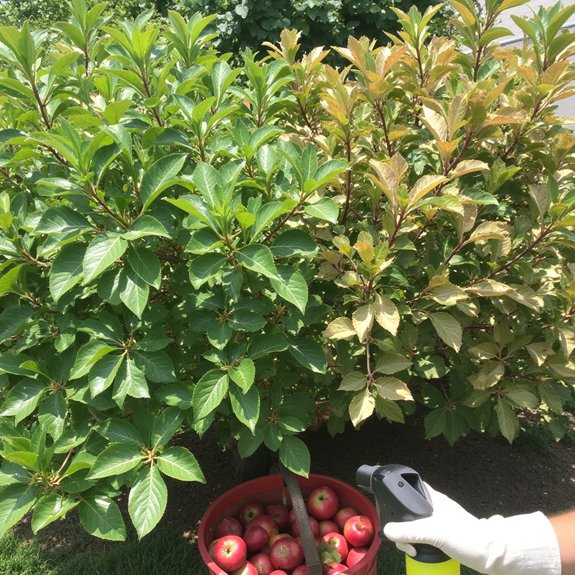Like Johnny Appleseed spreading his horticultural wisdom across the frontier, you’re about to commence a journey that’ll transform your backyard into a productive orchard. Growing apple trees isn’t just about sticking a sapling in dirt and hoping for the best—it requires understanding their 4,000-year heritage, mastering grafting techniques, and creating the perfect balance of soil pH, sunlight exposure, and pest management. The secret lies in timing your actions with nature’s rhythm, but there’s one critical mistake most beginners make.
Contents
- 1 The Rich Heritage and Global Journey of Apple Trees
- 2 Effective Propagation Techniques and Planting Best Practices
- 3 Essential Growing Conditions for Thriving Apple Trees
- 4 Watering, Soil, and Fertilization Requirements
- 5 Managing Pests, Diseases, and Preservation Methods
- 6 Expert Tips for Long-Term Success and Fruit Production
The Rich Heritage and Global Journey of Apple Trees

While many fruit trees have fascinating backstories, apple trees stand out with their remarkable 4,000-year journey from wild ancestors to beloved backyard staples. You’re growing descendants of Malus sieversii, which spread along ancient Silk Road trade routes, creating today’s incredible variety through natural hybridization.
The cultural significance runs deep—you’ll find apples referenced throughout literature, art, and folklore across civilizations. Historical cultivation transformed these trees from wild forest dwellers into garden centerpieces that now grace backyards worldwide. China leads global production today, but you’re part of this ancient tradition when you plant your own tree.
Effective Propagation Techniques and Planting Best Practices
Since grafting delivers the most reliable results for apple propagation, you’ll want to skip the tempting but unpredictable route of growing from seed. Grafting techniques guarantee disease resistance and true-to-parent fruit quality, making them far superior to seed propagation methods.
Plant in early spring, spacing standard trees 20 feet apart for proper cross-pollination. Dwarf varieties need only 10 feet between them. Dig holes matching your pot’s depth but double the width, removing competing grass and weeds first.
Avoid low-lying areas where cold air settles, potentially damaging delicate blossoms and reducing your harvest potential.
Essential Growing Conditions for Thriving Apple Trees

Success with apple trees demands patience, mental stamina, and attention to their fundamental needs. Your trees require full sunlight exposure—at least six hours daily for optimal fruit production. Without adequate light, you’ll see poor flowering and disappointing harvests.
Soil temperature matters greatly for root development and nutrient uptake. Well-draining, slightly acidic soil with pH 6-7 creates ideal growing conditions. Test drainage before planting to prevent root rot issues.
Water consistently, providing approximately one inch weekly, especially during establishment. Since apples consist of 86% water, proper hydration prevents stress that hinders flowering and fruiting success.
Watering, Soil, and Fertilization Requirements
Although apple trees aren’t particularly demanding, getting their watering schedule right makes the difference between a thriving orchard and struggling saplings. You’ll need approximately one inch weekly, especially during those vital first months after planting. Deep, infrequent irrigation techniques work better than shallow daily sprinkles.
Your soil should drain well while maintaining a pH between 6-7. If drainage seems poor, you’ll want soil amendments like compost mixed in before planting.
Fertilizing isn’t always necessary, but slow-release organic options applied once in spring can boost struggling trees. Avoid overfertilizing, which creates more problems than benefits.
Managing Pests, Diseases, and Preservation Methods

When pests and diseases inevitably find your apple trees, you’ll face challenges ranging from tiny aphids to devastating fire blight. Effective pest control starts with horticultural oil applications and strategic trapping for apple maggots and codling moths. Scale insects respond well to dormant oil sprays in late winter.
Disease management requires vigilance against apple scab and rust. Remove infected leaves promptly, guarantee proper air circulation, and avoid overhead watering. Fire blight demands immediate pruning of affected branches, cutting 12 inches below visible damage.
For preservation, wrap individual apples for 1-2 month refrigerator storage, or slice and freeze with lemon juice treatment.
Expert Tips for Long-Term Success and Fruit Production
While many gardeners focus solely on immediate care, establishing long-term apple tree success requires strategic planning that extends well beyond the first harvest. Master essential pruning techniques by removing dead, diseased, and crossing branches annually during dormancy. This opens the canopy, improving air circulation and sunlight penetration.
Develop consistent seasonal care routines that adapt to your tree’s changing needs. Spring demands fertilization and pest monitoring, summer requires deep watering and fruit thinning, fall means harvest preparation and cleanup, while winter focuses on dormant pruning and protection planning.
Patience pays dividends—mature trees reward dedicated caretakers with decades of abundant fruit production.
